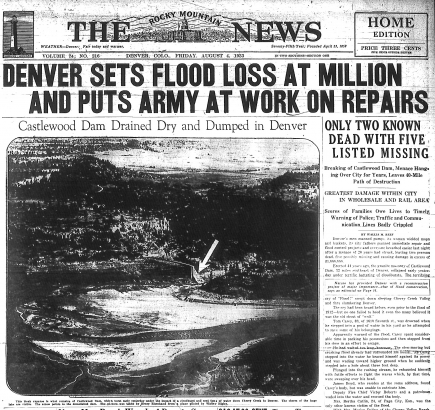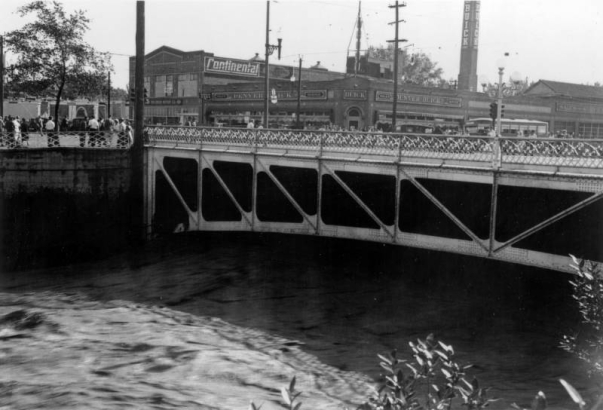We must have floods on the brain here at DPL's Western History/Genealogy department.
Last week, we brought you a glimpse of the 1914 Cornet Creek flood in Telluride. This week, we're focusing on the floodwaters that deluged the Denver area 82 years ago this August.
[CLICK HERE TO VIEW PHOTOS OF THE 1933 DENVER FLOOD]
Around 1 a.m. on August 3, 1933, the Denver metropolitan area received a, "terrific battering of cloudbursts." The rains caused Castlewood Dam, an irrigation reservoir located 32 miles southeast of Denver, to collapse.
The Denver Post reported:
It was exactly 2:38 a.m. when Denver first learned that flood waters had broken the Castlewood dam, and that a wall of water would rush into the city...Timely warnings that a fifteen-foot wall of water was rampaging down the creek...saved the lives of many persons.
Every police car and fire truck in the city was called out shortly before 4 a.m. to warn residents of the "bottom" lands to evacuate and to rescue families which might be marooned.
The water that rushed towards Denver was significant, as Castlewood Dam was roughly three times the size of Sloan's Lake. Dwight D. Gross, chief engineer for the Denver Board of Water Commissioners was quoted by the ;Denver Post on August 4, 1933:
Approximately one and one-half billion gallons of water passed through Denver in six hours during and immediately after the flood. This water, heavily laden with dirt, deposited a residue of silt within Denver’s city limits which would weigh, at the very least, 20,000 tons.”
A team of approximately 2,500 men worked to clean up the flood's grimy aftermath. Construction projects soon got under way to rebuild the destroyed bridges in the area.
Besides mud and washed out bridges, Denver residents endured flooded basements and downed phone and power lines. Displaced residents found shelter in Denver's downtown hotels. Two people perished in the flood: 83-year-old Tom Casey, who drowned while attempting to save belongings in his home, and Bertha Catlin, a 24 year-old woman from Page City, Kansas whose horse "threw her into the swirling waters" while she rode to view the flood damage.
Interested in learning more about the 1933 flood? Stop in to DPL's Western History/Genealogy department to peruse August 1933 newspapers on microfilm or to view the following items:






Comments
We have visited and hiked
We have visited and hiked Castlewood Canyon State Park for many years. Take the family and hike the canyon trail or around the southwest side of the park to the old broken dam. You really get the feeling of how the break must have sounded. As you look north from the dam, you can see large boulders and damn debris carried for as far as you can see.
Thanks for sharing the newspaper story and awesome photos!
You've inspired me to plan a
You've inspired me to plan a hike in Castlewood, Mike! Thanks for reading and commenting!
So interesting! This made me
So interesting! This made me go down a little bit of a rabbit hole looking for info on when and how the Cherry Creek retaining wall infrastructure was built. It looks so modern to me. I was surprised to see it in these photos.
Thanks for reading and
Thanks for reading and commenting, Hillary! I found an article citation regarding the retaining wall's construction in 1902 in our Western History Subject Index:
"Plans to improve Cherry Creek; course to be straightened with stone retaining wall." Denver Times, November 12, 1902 page 2, column 7
Neat! It looked like there
Neat! It looked like there were early, wooden retaining walls that didn't work out so well. http://cdm16079.contentdm.oclc.org/cdm/ref/collection/p15330coll22/id/66028
Thanks, Hillary! Wood & water
Thanks, Hillary! Wood & water don't seem like great companions!